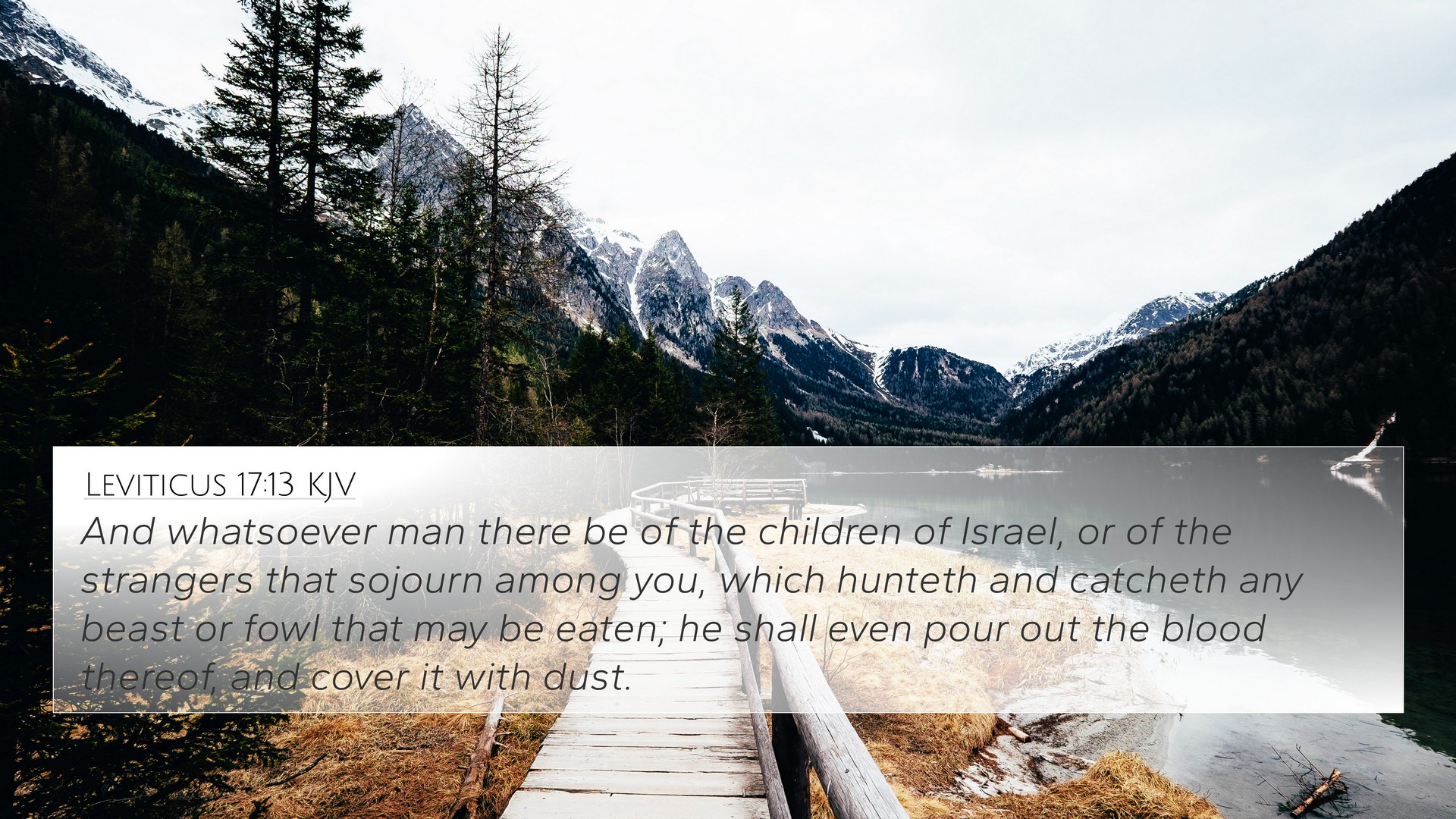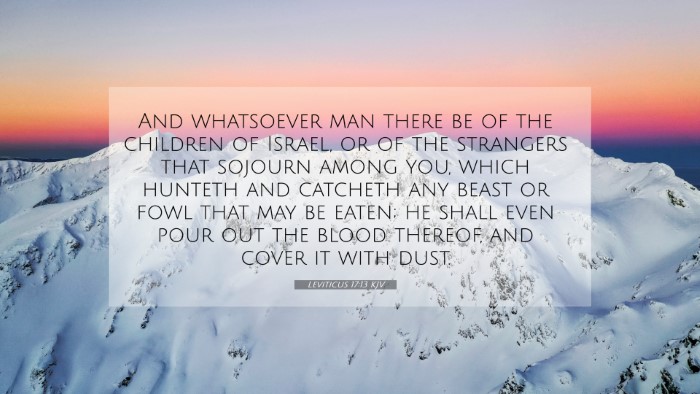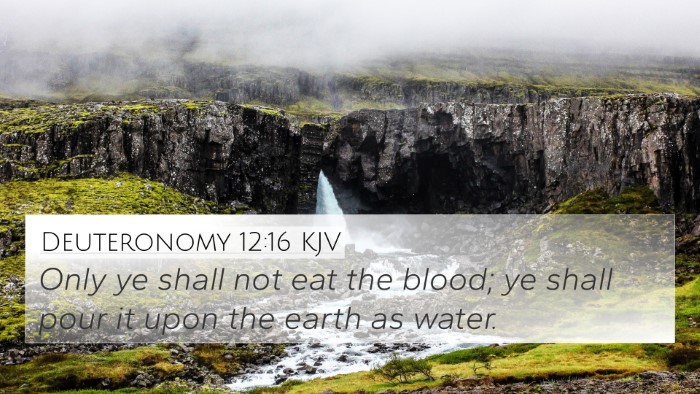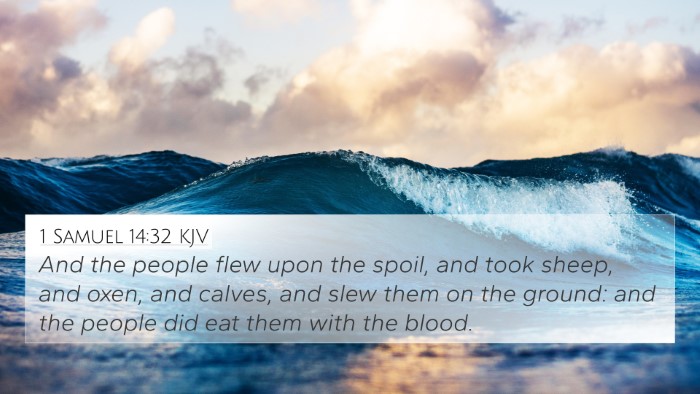Understanding Leviticus 17:13
Leviticus 17:13 states, "And any man of the children of Israel, or of the strangers that sojourn among them, which hunteth and catcheth any beast or fowl that may be eaten; he shall even pour out the blood thereof, and cover it with dust." This verse is pivotal in understanding the regulations surrounding animal sacrifice and the significance of blood within the context of ancient Israelite worship. Below is a detailed exploration of its meaning, connections, and implications.
Meaning and Interpretation
This verse emphasizes the sanctity of blood, as it represents life and is closely associated with atonement and sacrifice in the Mosaic Law. The act of pouring out blood and covering it with dust signifies respect for the life that was taken, highlighting the seriousness of shedding blood.
Public Domain Commentaries Insights
- Matthew Henry: Henry emphasizes that God sought to instill a reverence for the lifeblood of animals, which must not be taken lightly. He interprets this as a directive for proper conduct among the Israelites in their worship practices.
- Albert Barnes: Barnes points out that this command was meant to guard against idolatrous practices and to ensure that the Israelites maintained an appropriate relationship with both the sacrificial system and the natural world.
- Adam Clarke: Clarke provides a historical perspective, noting that this verse reflects a unique principle found in Israelite culture concerning the treatment of blood, which is considered sacred and essential in the process of atonement.
Connections to Other Scripture
This verse can be cross-referenced with several other biblical texts that reinforce its themes of blood sanctity, sacrifice, and atonement:
- Leviticus 17:11: "For the life of the flesh is in the blood: and I have given it to you upon the altar to make an atonement for your souls..." This verse establishes the foundational principle that blood serves as an atonement for sin, contextualizing the command in Leviticus 17:13.
- Genesis 9:4: "But you must not eat meat that has its lifeblood still in it." This early command to Noah emphasizes the seriousness of blood as life and foreshadows the sacrificial system later established in Leviticus.
- Hebrews 9:22: "And almost all things are by the law purged with blood; and without shedding of blood is no remission." This New Testament reference ties the Old Testament's understanding of blood sacrifice to the ultimate sacrifice of Christ.
- Exodus 12:13: "And the blood shall be to you for a token upon the houses where ye are: and when I see the blood, I will pass over you." This verse links to the theme of protection and deliverance tied to the use of blood in rituals.
- 1 John 1:7: "The blood of Jesus Christ his Son cleanseth us from all sin." This highlights the continuity of the blood theme from the Old into the New Testament, showing its ultimate fulfillment in Christ.
- Revelation 1:5: "...Unto him that loved us, and washed us from our sins in his own blood." This underscores the finality of Christ's sacrifice which connects with the previous verses' concepts of blood being vital for forgiveness.
- Matthew 26:28: "For this is my blood of the new testament, which is shed for many for the remission of sins." Here, Jesus pivots the Old Testament sacrificial system to its culmination in His sacrifice.
Thematic Connections and Comparative Analysis
In studying Leviticus 17:13 in conjunction with these scripture passages, one can identify a thematic pulse throughout the Bible that regards blood as sacred and integral to the covenant relationship between God and His people.
When exploring the connections between the Old and New Testaments, it becomes evident that the emphasis on blood points towards a greater theological framework concerning sin, atonement, and redemption. The sacrificial system laid out in Leviticus serves as a precursor to understanding the significance of Christ's sacrifice, which fulfills the need for atonement in a singular, definitive manner.
The Role of Cross-Referencing in Biblical Study
Cross-referencing Biblical texts can deepen our understanding of complex verses like Leviticus 17:13. Here are some effective tools for Bible cross-referencing:
- Bible Concordance: A useful tool to find corresponding verses by keywords.
- Bible Cross-reference Guide: Groups verses that relate to similar themes or topics.
- Bible Reference Resources: Comprehensive tools for studying connections between scriptures.
- Cross-reference Bible Study: Methods of examining verses side by side to unearth deeper meanings.
Conclusion
In summary, Leviticus 17:13 serves as a rich source for understanding the weighty themes of life, death, and divine mandate surrounding blood in the biblical context. By recognizing the connections between this and other scriptures, one can engage in a more profound thematic Bible verse connection. The insights from public domain commentaries offer a wealth of understanding that enhances our interpretation of the text and its relevance through time.









